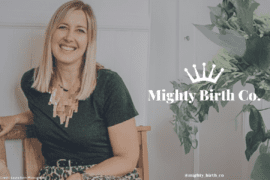Physically, I felt great. My pregnancy journey was as good as I could have hoped for.
I then discovered two less commonly discussed risk factors: anxiety and depression. According to PANDA (Perinatal Anxiety & Depression Australia), anxiety and/or depression is experienced by up to 25% of mothers both during pregnancy and/or following birth. In addition, up to 10% of expecting or new fathers experience anxiety and/or depression.
According to PANDA (Perinatal Anxiety & Depression Australia), anxiety and/or depression is experienced by up to 25% of mothers both during pregnancy and/or following birth.
I found the state of my mental health fluctuated during my pregnancy journey. It started after months of IVF treatment and medications. I was not even pregnant, and thought my dark feelings were a result of nine months of failing to fall pregnant. But then I held a positive pregnancy test and still experienced those dark feelings. One part of me was filled with joy and excitement and the other part felt like I was at the bottom of a dark hole.
I finally talked with my therapist about my feelings, and she asked me to complete the 10-question Edinburgh Postnatal Depression Scale (EPADS) to rate how I felt over the past 7 days. The results showed I was experiencing perinatal depression. But how could I be experiencing depression? I had a wonderful man in my life, and I was pregnant, something I only ever dreamed of. I was happy, except for these sneaky dark thoughts that seemed to attack me without notice.
Knowing I was experiencing symptoms of perinatal depression was somehow reassuring. At least I knew what I was facing. I sought help and further explored various mindfulness and meditation techniques.
Writing in my journal allowed me to explore my thoughts and feelings. Sharing this with my partner allowed us to talk and share our feelings in an open and authentic way. Writing affirmations and repeating these to myself helped counteract those dark thoughts that would slip into my mind. Regular meditation and sound healing helped to calm my heart and mind. Listening to peaceful music helped me relax and slow down.
Writing in my journal allowed me to explore my thoughts and feelings. Sharing this with my partner allowed us to talk and share our feelings in an open and authentic way.
Most importantly, attending regular appointments with my therapist helped me make sense of everything that was happening inside my mind.
When I was wheeled into the operating room for my caesarean section, I felt a sense of relief and pride. I ended the 38 weeks and 4 days of my pregnancy journey with a healthy mind and body. My partner held my hand and guided me through a beautiful meditation. The next thing I knew, I was holding my perfectly beautiful and healthy daughter to my chest with tears running down my face and love in my heart.
Look for my article next month when I share the story of my mindfulness journey with my newborn angel.
Statistics obtained from:
https://evidencebasedbirth.com/advanced-maternal-age/
https://panda.org.au/articles/how-common-is-mental-illness-in-the-perinatal-period/
https://www.nichd.nih.gov/health/topics/high-risk/conditioninfo/factors#
April Kinney is a mother and owner of Kinney & Kinney, a coaching and mentoring company based in Perth, Australia. At age 49, she successfully navigated a corporate career over twenty years and is now a Certified Master Practitioner in Neuro-Linguistic Programming, a Certified Master Practitioner in Timeline ® Therapy and a Certified Hypnotherapist. April’s mission is to help women navigate their life challenges with clarity and confidence to create a life of purpose and meaning. You can follow along with her journey at www.aprilkinney.com and https://www.facebook.com/AprilLKinney.










